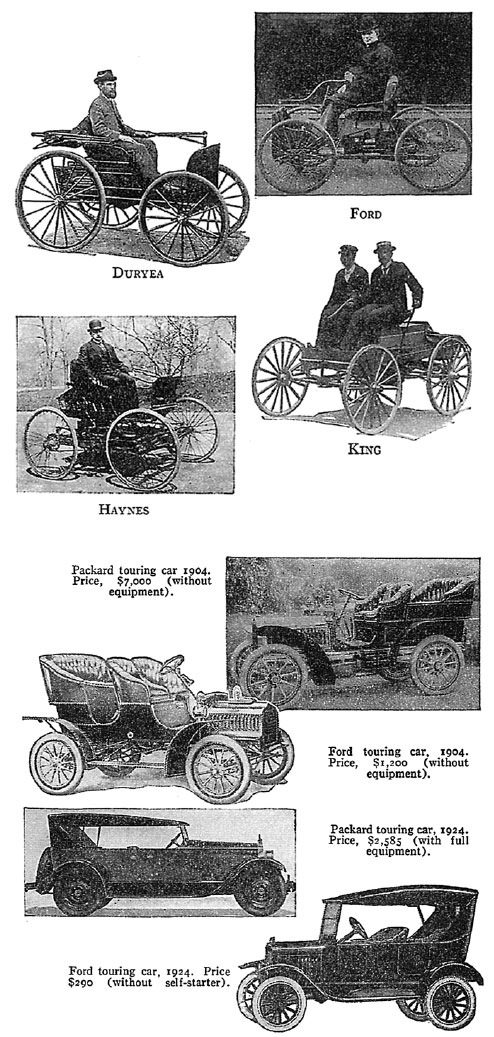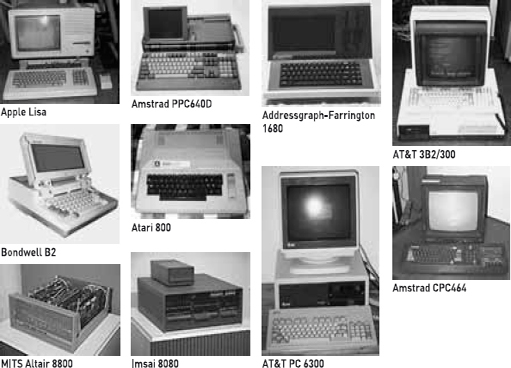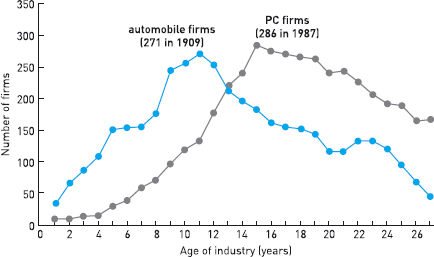4.3 Live fast, die young
Both the automobile and PC industries were characterised by a great deal of turbulence in the first 20 to 30 years of their existence. In both cases, many new firms entered the industry, introduced new varieties of the product, and soon left the industry, leaving only a few dozen firms to compete during the growth phase. By 1926 only 33 per cent of the firms that had started producing automobiles during the previous 22 years had survived. In the case of PCs, by 1999 only 20 per cent of the firms that had started producing PCs had survived. In both cases, the majority of firms did not last more than five years! This turbulent ‘live fast, die young’ period of great entry and exit is characterised by a lot of technological change. Let us look at this in more depth.

The hobbyist period in the automobile industry lasted approximately from 1885 to 1900. The first internal-combustion engine was invented in 1877 by Nikolaus Otto in Germany, and the first car (three-wheeled!) was invented in 1885 by Karl Benz, also in Germany. The first four photographs in Figure 2 show that between 1893 and 1899 automobiles were simply ‘horseless carriages’. They were the products of experiments carried out by ‘tinkerers’ in their homes or workshops. Carroll and Hannan (2000) document 3845 ‘pre-production’ organising attempts in the US automobile industry, of which only 11 per cent reached the market place.
The introductory period, in which cars began to be manufactured commercially, started in 1900. Before this date the automobile industry was not even listed in the census of manufacturers under a separate heading, yet by 1926 it had already attained an equal importance to shipbuilding and railroads (Epstein, 1928, p. 30). In 1901 Oldsmobile produced the world's first mass-produced automobile, and in 1910 the Ford Motor Company used the industry's first branch-assembly plant, that is, an assembly-line system for mass-producing cars, to produce the Model T, which soon became close to an industry standard. The period between 1900 and the end of the 1920s witnessed the most variety in product versions ever experienced in the industry. The second set of four photographs in Figure 2 shows some of the automobiles that emerged from this period of experimentation and tinkering.
Before 1973, the computer industry was formed around the production of the mainframe computer, dominated by IBM since the 1960s, and the minicomputer, the embryonic form of today's PC, dominated by Digital Equipment Corporation (whose computer was called the PDP-8). The first mass-produced computer was introduced by Micro Instrumentation and Telemetry Systems in 1974 (the MITS Altair 8800). As in the automobile industry, in the early years (up to 1980) demand was concentrated among hobbyists. The new start-ups were very similar to the early ‘tinkerers’ in the automobile industry: production was often organised out of a structure that looked like a garage, and the producers were driven by creativity and a passion for the product. As in the automobile industry, entry occurred mainly through product innovation. Figure 3 illustrates the wide range of product designs in these early years.
The introductory period in the PC industry, in which real commercial growth began, occurred only after IBM introduced the IBM ‘PC’ in 1981, initiating the phase of IBM ‘compatibility’ (both hardware and software) which later allowed economies of scale to operate in the industry. Three further developments markedly increased the growth of the PC industry: (1) Intel's introduction of the 32-bit 386 processors in 1985, which allowed graphical interfaces and hence a more user-friendly environment; (2) the introduction of Windows 3.0 in 1990, which standardised the PC on the Windows operating systems, allowing ‘cloning’ of the IBM PC; and (3) the rise of the World Wide Web in the 1990s. All three developments contributed to a rapid increase in sales and, later, to a rapid fall in prices.

Hence, in both industries the early years were characterised by a great deal of turbulence: new firms entering the industry with new product innovations, and industry growth taking off. Figure 4 depicts this turbulence graphically as the rise and fall of firm numbers (i.e. how many firms exist in the industry in a given year) for the first 30 years or so of each industry. The vertical axis shows the number of firms; the horizontal axis shows the age of the industry for its first 27 years.
Question
Look at Figure 4. What was similar about the early years of the US automobile and PC industries?

Answer
The two industries experienced a remarkably similar pattern of growth: both industries went from infancy to just below 300 firms in only 10 to 15 years. The peaks of the curves in Figure 4 illustrate that there was a maximum of 271 automobile firms in 1909 and a maximum of 286 PC firms in 1987. After this point, the industries experienced a ‘shake-out’, that is, the elimination of a large number of firms, which in the case of the US automobile industry culminated in the survival of only three domestic firms.
What caused the great number of exits, or ‘shake-outs’, from the two industries? As predicted by life-cycle theory, most of the firms left the two industries at around the time the product became standardised, that is, when the great experimentation with different product types had ended and the industry had consolidated around a particular standard. In the automobile industry this occurred around 1910, soon after the Model T was introduced. In the PC industry it occurred around 1990, soon after the new Wintel platform emerged (the combination of the Windows operating system and the Intel processor), which set a new standard for the industry.
Once the product had become standardised, companies focused on increasing the efficiency of production through process innovations. For example, greater efficiency was achieved by introducing mass-production techniques, which allowed economies of scale. The term ‘economies of scale’ refers to the dynamic by which an increase in the quantity produced allows the firm to spread its costs over a larger output, which lowers the cost of producing each unit of output. Mass production also allows improvements in efficiency from ‘learning by doing’: the more that is produced, the more that is learned, from experience, about how to make production more efficient. As large firms, by definition, achieve a higher scale of production (‘scale’ is measured by level of output), small firms are forced out of the market in the phase in which scale matters the most.
